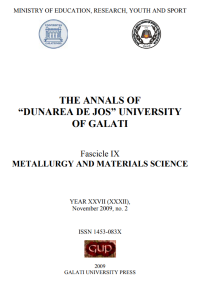Study of Zro2/Co-Deposition with Cobalt from Chloride Electrolyte
Abstract
The metal-matrix composites are materials in which the properties of a metallic host material are modified with addition of a second phase (ceramics) by electrodeposition process. The second phase can be hard oxides or carbides particles or diamond, or solid lubricants or even liquid containing microcapsules. Most composite coatings contain micron-sized particles. The major challenges with the codeposition of second phase particles are the achievement of a high level of codeposition and avoiding the agglomeration of particles suspended in the electrolytes. The poorly homogeneous distribution of second phase particles in the metallic matrix can be detrimental to the mechanical properties. This work shows the most recent results regarding the influence of ZrO2 bioceramic dispersed in the cobalt matrix during electroplating process from a chloride cobalt electrolyte. The ZrO2/Co composite coatings were electrodeposited from a suspension of ZrO2 particles (mean diameter 10 μm) in aqueous cobalt chloride electrolyte. Suspension was prepared by adding 20 g/L ZrO2 particles into solution. Co-deposition of dispersed micro sized particles with cobalt during electroplating process influences the structure and surface morphology of composite coatings obtained. The pure cobalt coating has a rather regular surface, whereas the composite coatings surface has fine different disturbed structure. The composite coating thickness increases with increasing the current density, whereas the content of ZrO2 particles inside the cobalt matrix decreases with current density.
Downloads
References
[2]. T.W.Clyne, P.J.Withers - An Introduction to Metal Matrix Composites, Cambridge University Press, Cambridge, 1993.
[3]. L.Benea, P.L.Bonora, A.Borello and S.Martelli - Wear 249 (2002), p. 994-1003.
[4]. L.Benea, P.L.Bonora, A.Borello and S.Martelli - Materials and Corrosion, 53 (2002), p. 23-29
[5]. T.L. Yau - Stress-corrosion cracking of zirconium alloys, in: R.H. Jones (Ed.), Stress-Corrosion Cracking: Materials Performance and Evaluation, ASM International, Materials Park, OH, 1992.
[6]. A. Heuer, L.W. Hobbs (Eds.) - Science and Technology of Zirconia, Advances in Ceramics, vol. 3, American Ceramic Society, Westerville, OH, 1981; Science and Technology of Zirconia II, Advances inn Ceramics, vol. 12, American Ceramic Society, Westerville, OH, 1984.
[7]. S. Somiya, N. Yamamoto, H. Yanagina (Eds.) - Advances in Ceramics, vols. 24A and 24B, American Ceramic Society, Westerville, OH, 1988.
[8]. X. Zhao, D. Vanderbilt - Phys. Rev. B 65 (2002) 075105.
[9]. E.J. Walter, S.P. Lewis, A.M. Rappe, Surf. Sci. 495 (2001) 44.
[10]. A. Meldrum, L.A. Boatner, R.C. Ewing - Phys. Rev. Lett. 88 (2002).
[11]. C. Morant, J.M. Sanz, L. Gal´an - Phys. Rev. B 45 (1992).
[12]. V. Fiorentini, G. Gulleri, Phys. Rev. Lett. 89 (2002).
[13]. R. Punthenkovilakam, E.A. Carter, J.P. Chang - Phys. Rev. B 69 (2004).
[14]. D. Hudson, A.Cerezo,G.D.W.Smith, Ultramicroscopy (2008).
[15]. F. Bratu, L. Benea, J.P. Jean-Pierre Celis Surf Coat. Technol 201(16-17), 2007, p. 6940.
[16]. A. Vicenzo, P.L. Cavallotti; Electrochim. Acta 49 (2004) 4079-4089.



